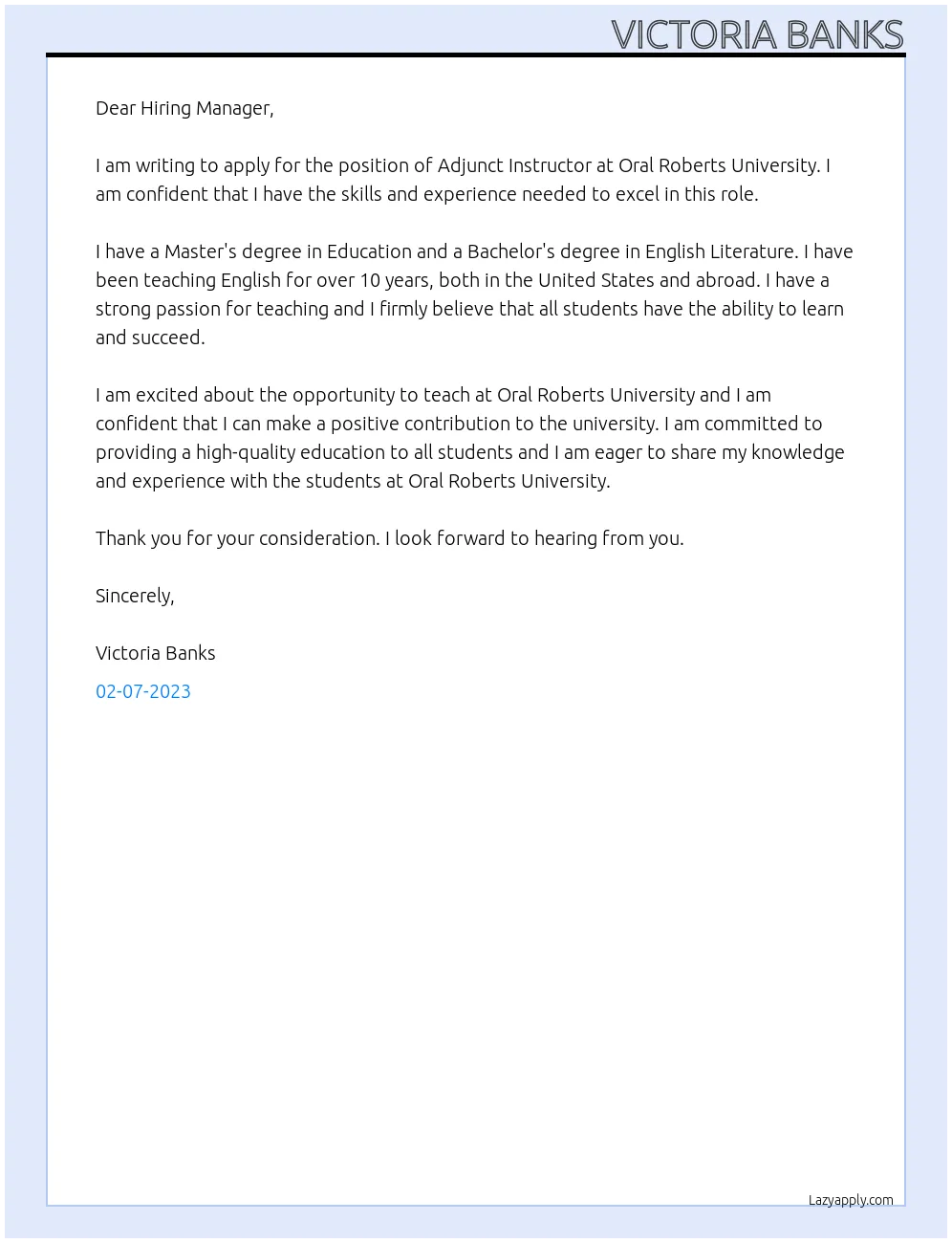What is an Adjunct Faculty Cover Letter
An adjunct faculty cover letter is a crucial document that accompanies your resume when applying for adjunct teaching positions. It serves as your introduction to the hiring committee, allowing you to showcase your qualifications, experience, and passion for teaching. Unlike a resume, which provides a chronological overview of your professional history, a cover letter allows you to elaborate on your skills and explain why you are the ideal candidate for the specific role. It’s your opportunity to make a strong first impression and persuade the hiring committee to review your resume in detail and ultimately, offer you an interview. The cover letter is a personalized narrative that highlights your unique value proposition as an educator and demonstrates your understanding of the institution’s needs.
Why is a Strong Cover Letter Important
A strong cover letter is extremely important because it’s your first chance to make a positive impression. In a competitive job market, especially in academia, a well-crafted cover letter can set you apart from other applicants who may have similar qualifications. It demonstrates your communication skills, attention to detail, and genuine interest in the position and the institution. A compelling cover letter allows you to tailor your application to the specific requirements of the job, highlighting the experiences and skills most relevant to the role. It provides an opportunity to explain any gaps in your resume or unique circumstances, and show how your background aligns with the institution’s mission and values. Without a well-written cover letter, your application might not receive the careful consideration it deserves, potentially leading to missed opportunities.
Key Components of an Effective Adjunct Faculty Cover Letter
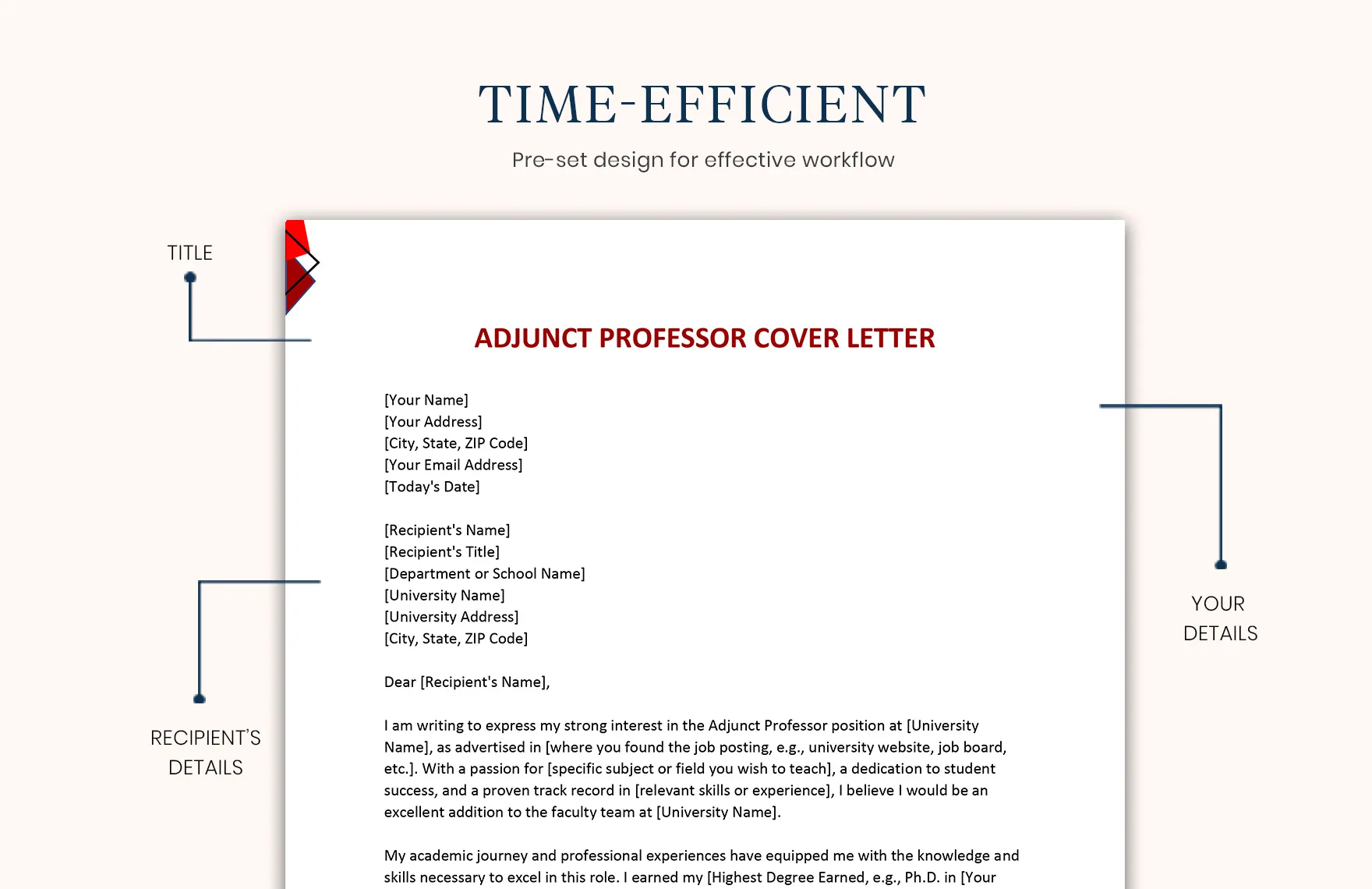
An effective adjunct faculty cover letter has several key components that work together to create a compelling narrative. Each section plays a vital role in showcasing your qualifications and demonstrating your suitability for the position. The following sections will explain each component in detail.
Contact Information
At the top of your cover letter, clearly state your contact information. This typically includes your full name, phone number, email address, and potentially your LinkedIn profile URL. Ensure that your email address is professional and that your voicemail is set up with a professional greeting. This makes it easy for the hiring committee to contact you promptly.
Addressing the Hiring Committee
Always address your cover letter to a specific person whenever possible. Research the department website or the job posting to find the name of the hiring manager or committee chair. Using a name shows that you have taken the time to learn about the institution and that you are genuinely interested in the role. If you cannot find a specific name, a general salutation like “Dear Hiring Committee” is acceptable, but avoid generic greetings like “To Whom It May Concern”.
Highlighting Relevant Experience
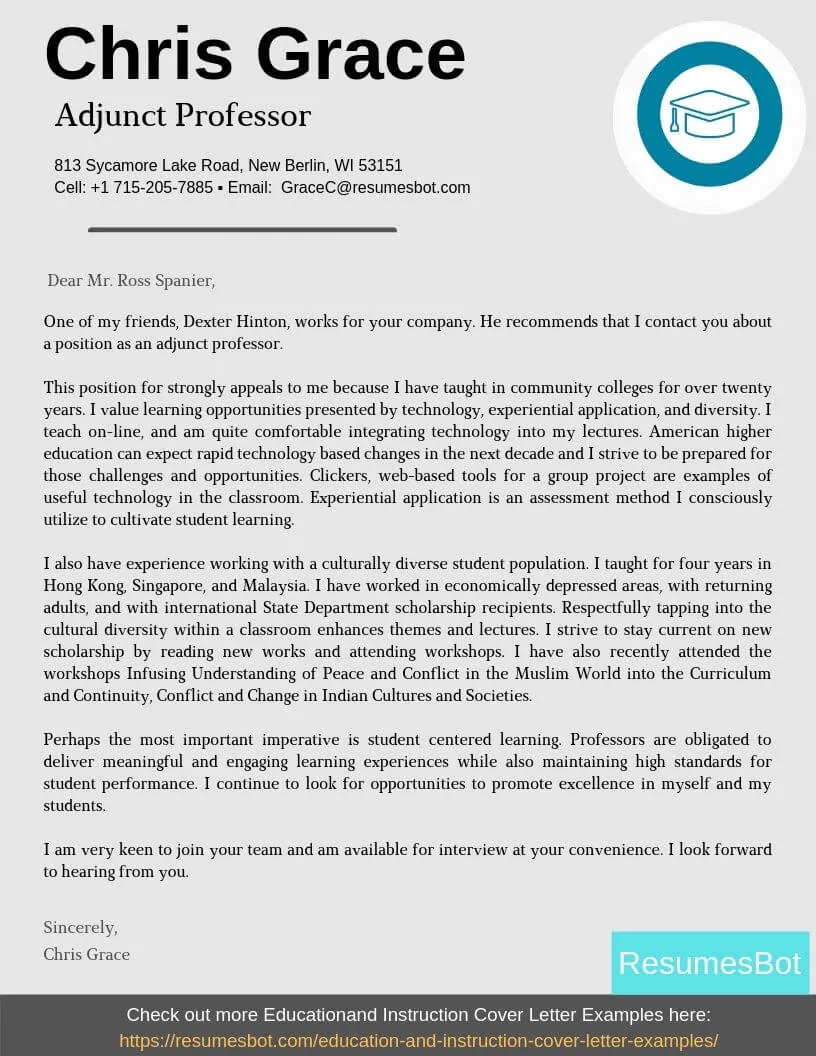
In the main body of your cover letter, highlight your relevant experience. Focus on the experiences most directly related to the adjunct faculty position. Include the specific courses you have taught, the levels of students you have worked with, and any specializations or areas of expertise. Provide concrete examples of your accomplishments and quantify them whenever possible. For instance, if you implemented a new teaching strategy that improved student performance, explain the results. Tailor your experience to align with the specific requirements outlined in the job description, as the hiring committee will be looking for candidates who demonstrate a clear understanding of the role and its responsibilities.
Education and Qualifications
Clearly state your educational background and qualifications. Include the degrees you have earned, the institutions you attended, and the dates of graduation. Mention any relevant certifications or licenses, such as teaching credentials or professional certifications. If your degree is not directly related to the subject you intend to teach, highlight the experience you do have. Emphasize how your education has prepared you for this specific adjunct faculty role.
Showcasing Teaching Philosophy
A well-crafted teaching philosophy is an essential component of your cover letter. Briefly describe your teaching philosophy, including your approach to student engagement, classroom management, and assessment. Articulate your beliefs about education, your teaching goals, and how you create a positive learning environment. Focus on your teaching methods and how you facilitate student success. This section allows you to demonstrate your ability to inspire and motivate students.
Emphasizing Skills and Expertise
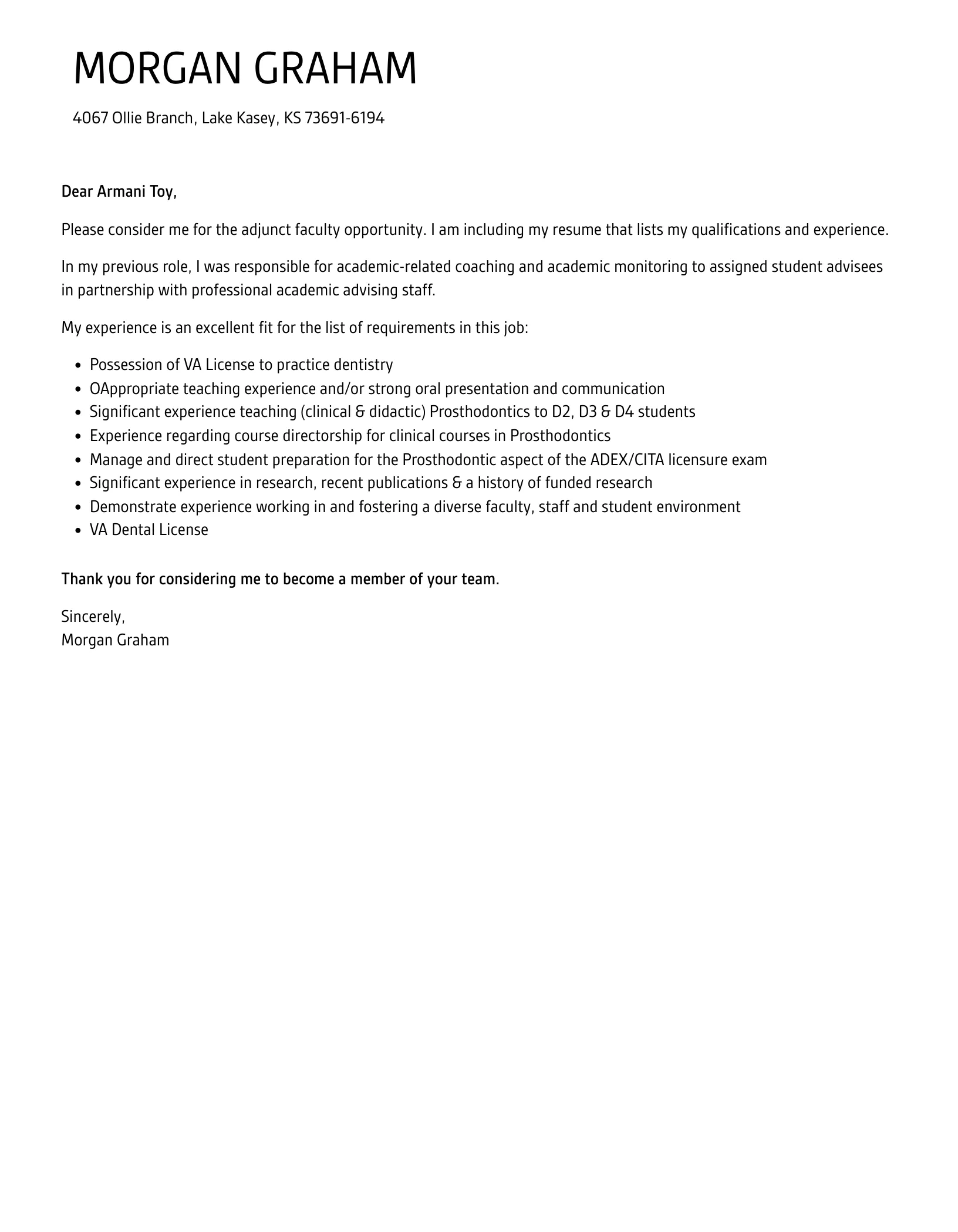
Highlight the specific skills and expertise that make you a strong candidate for the adjunct faculty position. Identify the key skills outlined in the job description and show how your skills align with their needs. Mention your subject matter expertise and any specialized skills, such as curriculum development, online teaching, or experience with specific software or technologies. Emphasizing these skills and expertise demonstrates your ability to excel in the role.
Demonstrating Passion for Teaching
Express your enthusiasm for teaching and your commitment to student success. Convey your passion for the subject matter and your desire to share your knowledge and experience with students. Show that you are dedicated to creating an engaging and supportive learning environment. Let the hiring committee know why you are genuinely excited about the opportunity.
Formatting Your Cover Letter for Success
The formatting of your cover letter can significantly impact its readability and professional appearance. Following some specific formatting guidelines can help you make the best impression. Here are some critical tips to make your cover letter stand out.
Choosing the Right Font and Style
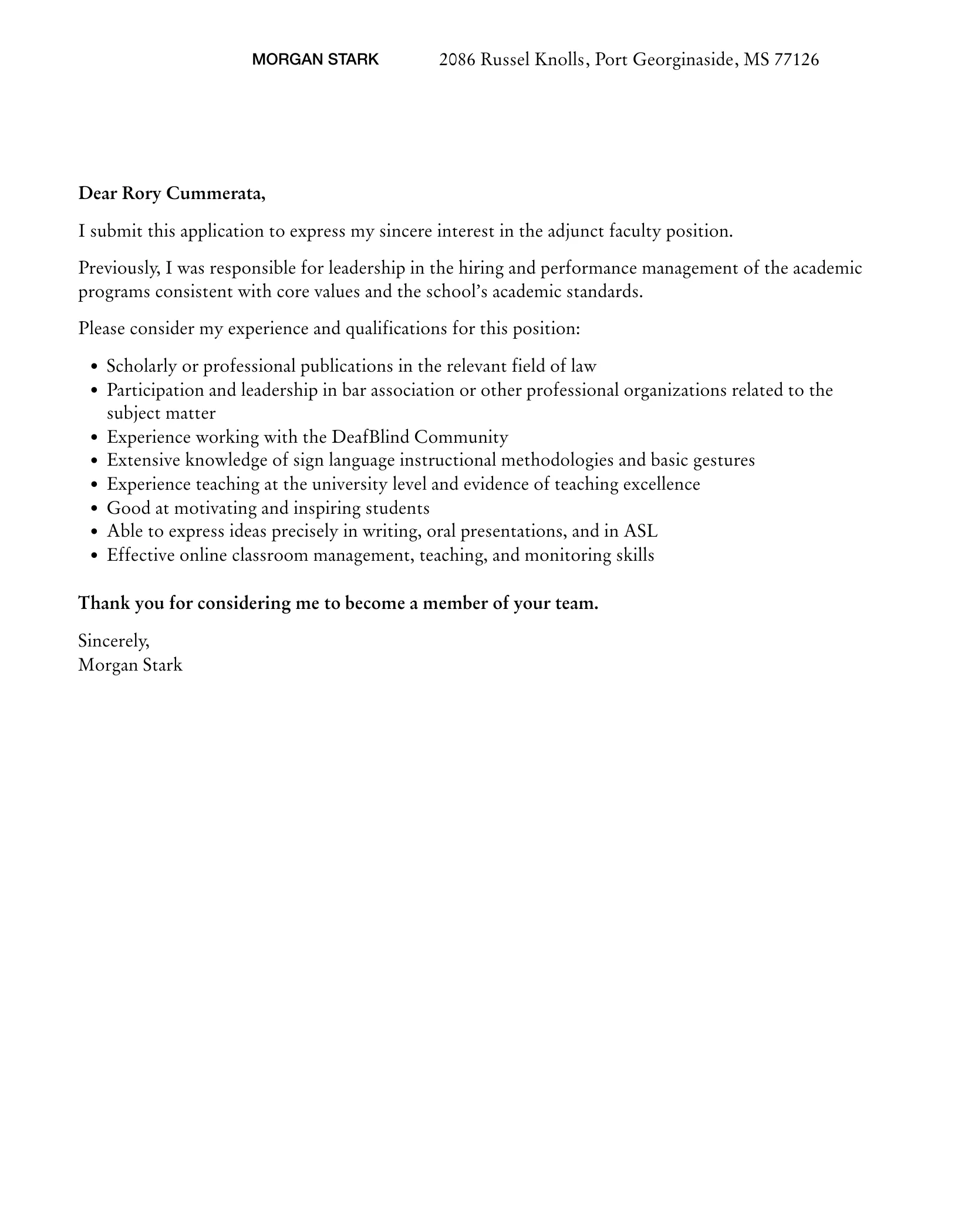
Select a professional and readable font, such as Times New Roman, Arial, or Calibri. Use a font size between 10 and 12 points for easy readability. Ensure your cover letter has a clean and uncluttered layout with clear headings and subheadings to guide the reader through the content. Use standard margins (1 inch on all sides) and single-spaced paragraphs, with a space between paragraphs. The overall goal is to create a visually appealing document that is easy to read.
Keeping it Concise and Professional
Keep your cover letter concise and to the point. Aim for a one-page document unless the job posting specifically asks for more. Use clear and concise language, avoiding jargon or overly complex sentences. Focus on the most relevant information and eliminate any unnecessary details. The goal is to provide a comprehensive overview of your qualifications in a way that is easy for the hiring committee to understand and review.
Proofreading and Editing Your Cover Letter
Proofread your cover letter carefully for any typos, grammatical errors, or spelling mistakes. Errors can reflect poorly on your attention to detail. Read your cover letter aloud to catch any awkward phrasing or sentences that don’t flow well. Consider having a friend, mentor, or career counselor review your cover letter for feedback. Paying attention to every detail will demonstrate professionalism and attention to detail.
Common Mistakes to Avoid in Your Adjunct Faculty Cover Letter
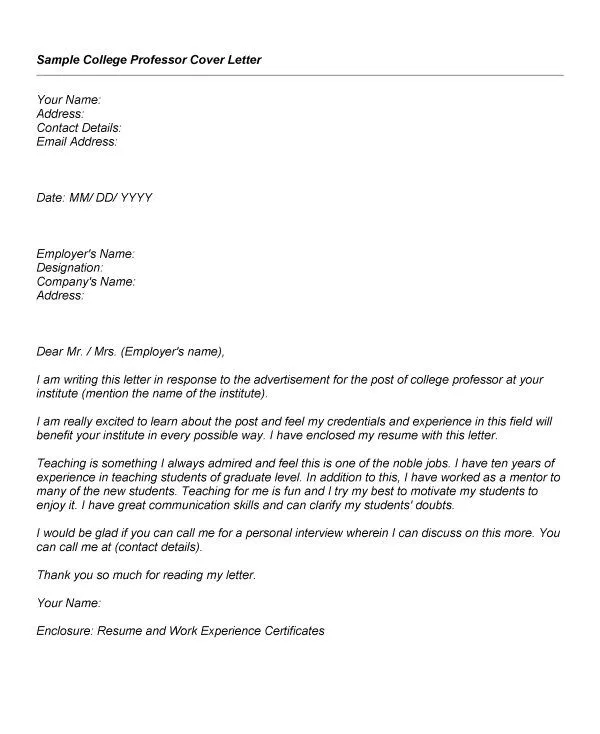
Several common mistakes can undermine the effectiveness of your cover letter. Avoiding these pitfalls is essential for making a strong impression and increasing your chances of securing an interview.
Generic Letters
Avoid sending a generic cover letter that could be used for any job application. Customize your cover letter to each specific position and institution. Demonstrate that you have researched the institution and understand its mission and values. Tailor your skills and experience to match the job requirements and show why you are the best fit for that particular role. Sending a generic letter suggests a lack of interest and a lack of investment in the specific opportunity.
Typos and Grammatical Errors
Carelessly written cover letters with typos and grammatical errors can make a poor impression. They reflect a lack of attention to detail and can lead the hiring committee to question your professionalism. Proofread your cover letter multiple times and consider using grammar-checking tools to catch errors. It is best to have someone else review your letter, as a fresh pair of eyes can catch things you might miss. A well-edited cover letter conveys professionalism and shows that you care about the quality of your work.
Lack of Customization
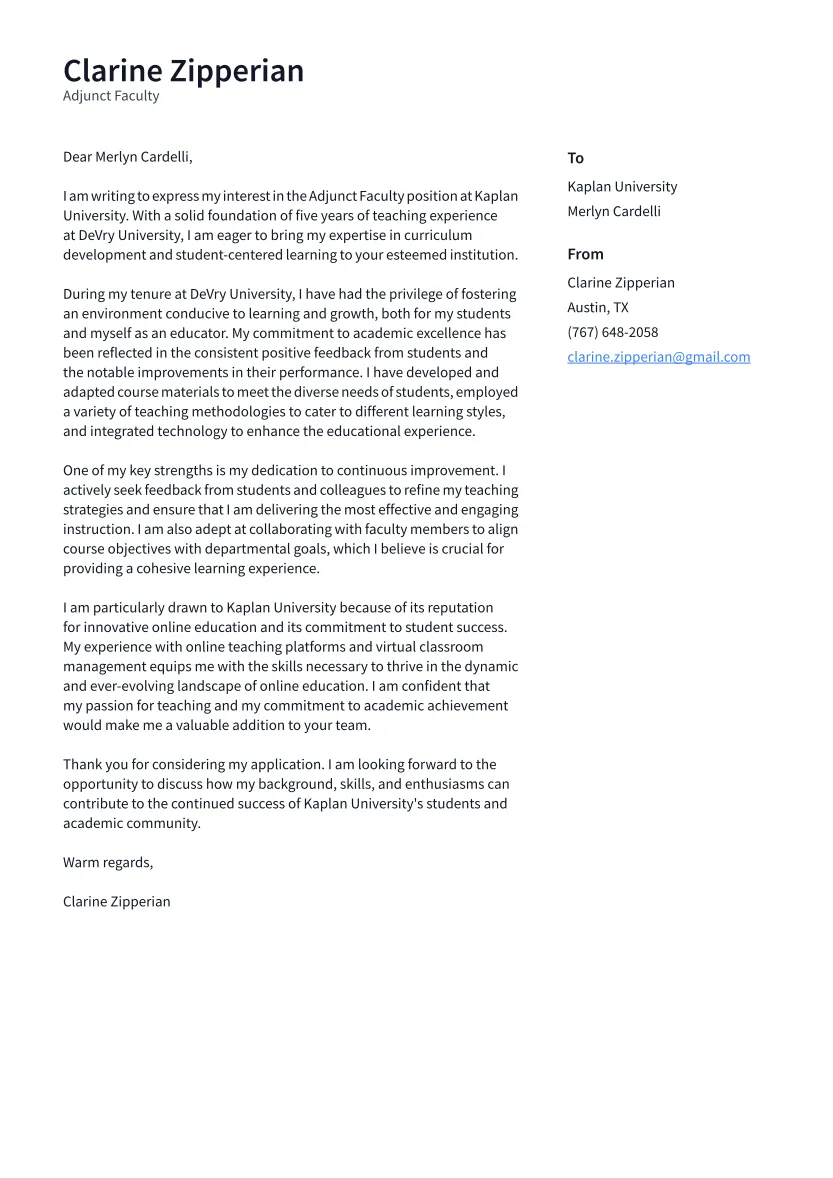
Failing to customize your cover letter to the specific job and institution is a significant mistake. Your letter must address the specific requirements of the role. Show how your qualifications align with the job description and highlight the skills and experiences most relevant to the position. Customize your letter to the institution by demonstrating an understanding of its values, mission, and any specific needs. This shows that you are genuinely interested in the position and that you have taken the time to learn about the opportunity.
Tailoring Your Cover Letter to the Specific Job
Tailoring your cover letter is critical for making a strong impression on the hiring committee. It’s not a one-size-fits-all document. You need to adjust your letter to the specific requirements of each job and the unique characteristics of each institution.
Researching the Institution and Department
Thoroughly research the institution and the department to which you are applying. Visit the institution’s website, read about their mission and values, and learn about the courses they offer. Identify the department’s goals and any recent initiatives. This information will help you tailor your cover letter to the specific needs and interests of the institution. Understanding the institution and the department shows that you are genuinely interested in the role.
Matching Your Skills to the Job Requirements
Carefully review the job description and identify the required skills and qualifications. Then, highlight the skills and experiences that align with the job requirements. Provide specific examples of how you have demonstrated these skills in the past. Use the keywords from the job description in your cover letter to show that you possess the necessary skills and qualifications. Tailoring your skills and experience demonstrates your understanding of the job and your ability to perform the required tasks.
Using Keywords from the Job Description
Incorporate keywords from the job description into your cover letter. These keywords help your cover letter get noticed by applicant tracking systems (ATS) and hiring managers. Use the same terminology used in the job description to showcase your relevant skills and experience. However, avoid keyword stuffing. Integrate the keywords naturally into your writing so that your cover letter reads smoothly and authentically. Using the right keywords increases the likelihood that your cover letter will be noticed and reviewed.
Adding a Compelling Call to Action
Conclude your cover letter with a compelling call to action. Express your interest in the position and your enthusiasm for the opportunity to contribute to the department and the institution. Include a statement that you are eager to discuss your qualifications in more detail. Thank the hiring committee for their time and consideration and provide your contact information. This is your final opportunity to reiterate your interest and encourage the hiring committee to contact you for an interview. A strong call to action reinforces your enthusiasm and commitment, increasing your chances of moving forward in the hiring process.
